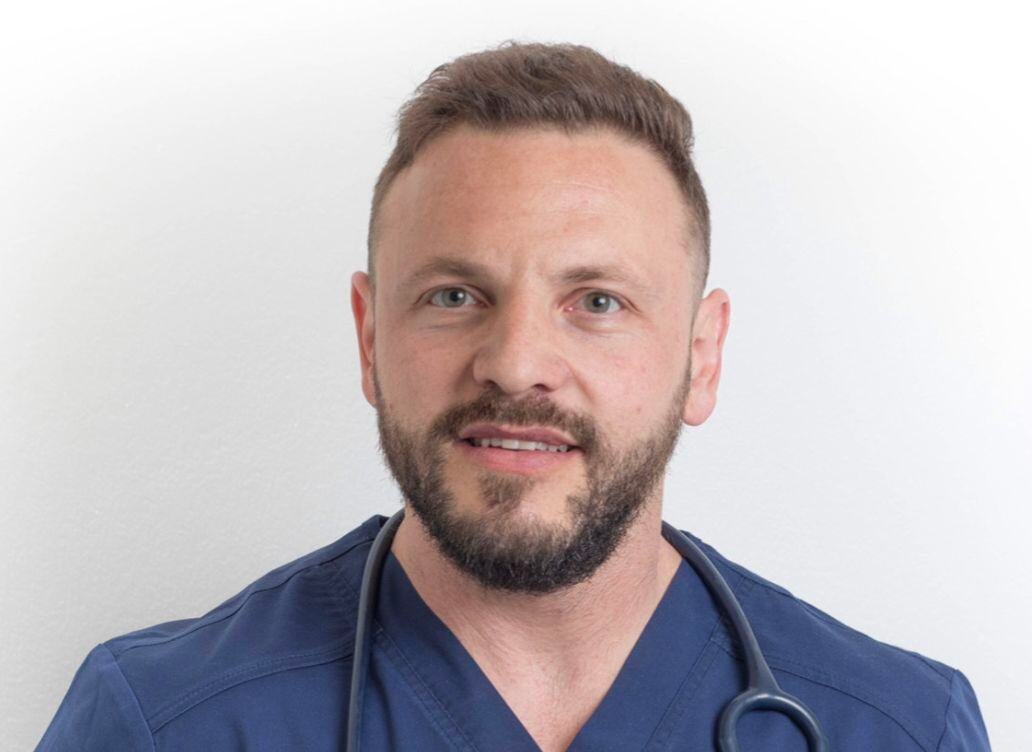
In the highly specialized field of head and neck surgery, a surgeon's role extends far beyond the operating room.
Dr. Mariano Sorrentino, an eminent figure in this field, epitomizes this expansive role. With his significant contributions to both clinical practice and medical research, he stands as a testament to how surgeons are redefining their roles in advancing healthcare.
Currently a PGY-3 General Surgery Resident at the Mayo Clinic, Florida, Dr. Sorrentino’s journey in the medical field began in Argentina, where he cultivated a deep interest in the complexities of head and neck anatomy.
He says: “My mother pursued an art career, and my father was an architect. However, my journey took a different direction early on. When I was about eight or nine, I underwent surgery on my right ear.
“This experience had a profound effect on me; it ignited a deep respect and admiration for the field of medicine, thanks to the surgeon who treated me.”
Dr. Sorrentino studied at the University of Buenos Aires School of Medicine, where he received his Doctorate in Medicine. He also completed a residency and chief residency in General Surgery at Hospital General de Agudos Dr. Enrique Tornu.
Then he attended a Head and Neck Surgery Fellowship at Marie Curie Oncologic Hospital.
Dr. Sorrentino reveals: “It’s interesting that in Argentina, head and neck surgery can be a subspecialty for general surgeons, ENTs, or plastic surgeons. I was drawn to complex, challenging environments and found the adrenaline and precision in surgery captivating.”
His pursuit of surgical excellence led him to the US, amassing a wealth of knowledge and experience.
He completed his United States Medical Licensing Examination (USMLE) and the ECFMG certificate.
Dr. Sorrentino also completed a Head and Neck Surgical Oncology Fellowship at Advent Health in Celebration, Florida, where he specialized in Microvascular surgery and trans-oral robotic surgery.
“The path of a surgeon is lifelong learning. Every case, every patient brings new insights,” Dr. Sorrentino remarks.
In this article, he discusses the role of a head and neck surgeon and the importance of minimally invasive surgery techniques.
Pioneering Minimally Invasive Techniques
“Minimally invasive surgical techniques have been game-changers in the operating room. I always attempt to push the boundaries of what is possible in surgeries so we can significantly reduce patient recovery time and improve outcomes.”
Dr. Sorrentino adds: “Minimally invasive surgery is not just about smaller incisions. It’s about a fundamental shift in how we approach and manage surgical interventions.
“It transcends the notion of merely making smaller incisions. It represents a profound shift in the strategy and execution of surgical interventions, emphasizing less intrusion into the body and a focus on precision and efficacy. “
According to Dr. Sorrentino, this approach not only minimizes physical trauma but also reduces the psychological stress on patients, fostering a quicker return to normal life.
He notes: “The advantages of minimally invasive techniques are particularly evident in head and neck surgeries. Traditional surgeries in these areas typically require large incisions and extensive tissue disruption and can lead to significant discomfort and lengthy recovery periods.”
However, by employing MIS techniques such as endoscopic surgeries, surgeons can operate with enhanced visibility and precision.
For instance, transoral robotic surgery (TORS) allows for the removal of tumors in the throat or base of the tongue without external incisions, using robotic instruments that offer superior manoeuvrability and control.
In the context of cancer surgeries, minimally invasive techniques have been groundbreaking. For patients with cancer, the dual goals of surgery are to remove the malignancy effectively and to do so in a way that maximally preserves the patient's function and appearance.
Dr. Sorrentino reveals: “Minimally invasive surgery also extends into treating cancers in more delicate areas, such as the brain. Techniques like neuroendoscopy enable surgeons to remove tumors through small openings in the skull or via natural orifices, drastically reducing brain trauma and recovery time.
“This method is particularly beneficial for tumors located in challenging or deep-seated areas of the brain.“
He adds: “Furthermore, integrating real-time imaging technologies like intraoperative MRI and CT scans enhances the precision of minimally invasive procedures. These imaging techniques provide surgeons with live feedback, allowing for more accurate tumor removal while preserving healthy tissue.
“Our goal is not only to remove cancer but to do so in a way that is as unobtrusive to them as possible and preserves their quality of life. Minimally invasive surgeries enable us to do that.”
A Commitment to Patient-Centered Care
As a surgeon, Dr. Sorrentino says commitment to patient-centered care is paramount: “It is essential to understand the patient's perspective and tailor their treatments to meet their needs.
“Surgery is a demonstration of technical skill and an embodiment of the surgeon's understanding of the patient’s journey and goals.
“This approach is especially crucial in the delicate fields of head and neck surgery, including both endocrine and oncological specialities.”
According to Dr. Sorrentino, patient-centered care in surgery involves several key components:
-
Thorough preoperative consultations
-
Individualized treatment planning
-
Post-operative care that addresses physical recovery and emotional well-being
He says: “This means actively listening to patients' concerns and expectations and integrating their preferences into the surgical plan whenever possible.
“For example, in the treatment of thyroid cancer, a common endocrine surgery, considerations might include the patient's concern about visible scarring and potential voice changes.
“Surgeons might opt for minimally invasive surgical techniques, such as robotic thyroidectomy or endoscopic approaches, which can be performed through smaller incisions and are less likely to impact vocal nerve integrity. These options are discussed with the patient, ensuring they are fully informed and comfortable with the chosen approach.”
Preserving the patient's quality of life is a critical focus in oncological surgeries for head and neck cancers. Procedures like transoral robotic surgery (TORS) allow for the removal of tumors without external incisions, which can preserve vital functions such as speech and swallowing and reduce the psychological impact of surgery.
Dr. Sorrentino reveals: “Patient-centered care in this context means clearly explaining the potential outcomes and ensuring the patient understands the balance between oncologic control and functional preservation.
“Moreover, reconstructive aspects of surgery are also tailored to the patient's expectations and lifestyle. For patients undergoing significant tissue removal due to cancer, reconstructive techniques using microvascular free flaps can be planned.
“These techniques are discussed with the patient to align with their expectations of post-surgical appearance and function, emphasizing state-of-the-art technology to achieve the best aesthetic and functional outcomes.”
He goes on to emphasize that post-operatively, patient-centered care continues with personalized rehabilitation plans, which may include speech therapy, physical therapy, and nutritional counseling, depending on the extent and location of the surgery.
Dr. Sorrentino says regular follow-up visits are scheduled to monitor recovery, address complications, and adjust ongoing treatment plans as needed.
“Overall, the integration of patient-centered care in head and neck surgeries, particularly in the fields of endocrine and oncology, focuses on removing disease and enhancing the patient's overall well-being and satisfaction with the surgical outcome,” Dr. Sorrentino says.
“This holistic approach underscores the importance of treating patients as active participants in their healthcare journey.”
Collaborating Across Disciplines
A staunch advocate for the power of interdisciplinary collaboration in the medical field, Dr. Sorrentino says his approach involves working closely with other specialists, including oncologists, radiologists, endocrinologists, and even speech therapists. By collaborating, they can offer comprehensive and holistic care to patients.
During his head and neck fellowships, which took place at the Head and Neck Fellowship was AdventHealth and Hospital Oncológico Maria Curie in Argentina, Dr. Sorrentino was trained to weekly review the most complex oncologic cases in a multidisciplinary meeting with medical and radiation oncology, nutrition and speech pathology.
His role involved not only reviewing these cases but also judging others' work, providing expert opinions and recommendations to ensure optimal patient care and treatment outcomes.
Dr. Sorrrentino spent three years in Argentina on his Fellowship and two years at Advent Health.
In his US fellowship, he had to present one to four cases at the multidisciplinary tumor board meeting weekly, which included other surgeons, a pathologist, a medical and radiation oncologist, and a speech pathologist.
At the gathering, he would seek advice and management on each patient and offer his expertise and opinion on cases his fellow surgeons were handling.
Dr. Sorrentino attended another meeting once a month with a similar format, which focused on discussing melanoma, cutaneous tumor, and other sin cancer cases.
He says: “This team-based strategy is pivotal, particularly in complex fields such as head and neck surgery and cancer treatment, where the integration of diverse expertise can significantly enhance patient outcomes.
“Interdisciplinary teams are essential in head and neck surgeries. For instance, when treating thyroid cancer, an endocrine surgeon might collaborate with an oncologist to determine the appropriate extent of surgery and any necessary adjunct therapies, such as radioactive iodine.
“Additionally, a radiologist plays a crucial role by performing and interpreting advanced imaging tests to guide the surgical plan and ensure that all areas of concern are addressed during the operation.”
Another area where collaborative care is vital is managing head and neck cancers, including oral, laryngeal, and pharyngeal cancers. Here, the surgeon works in tandem with oncologists to plan the best course of treatment which may include surgery, radiation, and chemotherapy.
Dr. Sorrentino reveals: “In trans-oral robotic surgery (TORS) for oropharyngeal cancer, surgeons rely on precise imaging from radiologists to navigate complex anatomy and preserve vital structures, while oncologists tailor adjuvant treatments based on the tumor's genetic markers and response to initial therapy.
“As well as this, reconstructive aspects after major cancer resections demonstrate the necessity of interdisciplinary teams.
“A surgeon may work alongside a reconstructive specialist to plan immediate reconstruction using microvascular free flaps, which not only focus on removing the cancer but also on achieving the best cosmetic and functional outcome for the patient.”
Challenges and the Way Forward
The field of head and neck surgery is constantly evolving, with new technologies and treatment modalities emerging. Staying abreast of these developments, particularly in minimally invasive surgery, and integrating them into practice is a continuous challenge.
Dr. Sorrentino concludes: “Looking to the future, I predict we will start to embrace a more personalized style of medicine, where treatments are customized based on the patient’s unique genetic makeup.
“We will soon have the education and skills at our fingertips to speed up patients' operations and recoveries. This will truly be personalized treatment for each person which can only lead to better outcomes and service for everyone.”
About Dr. Mariano Sorrentino
Dr. Mariano Sorrentino is a highly skilled General Surgery Resident currently at Mayo Clinic in Florida, where he is building on his extensive expertise in surgical techniques and patient care.
His dedication and skill have been shaped by a distinguished fellowship at AdventHealth Celebration in Florida, specializing in head and neck surgery, head and neck surgical oncology, and endocrine surgery.
Dr. Sorrentino has a keen research interest in both robotic and endocrine surgery, positioning him at the forefront of innovative surgical techniques.
Before his current role at Mayo Clinic, Dr. Sorrentino completed a fellowship at AdventHealth.
During this time, he focused on advanced training in head and neck surgery, gaining invaluable experience in various surgical procedures and patient management.
He has also served as a Trauma Surgeon at Hospital Oncológico Maria Curie, where he treated critical and emergency cases.
Additionally, Dr. Sorrentino participated in an observer and research rotation at AdventHealth during 2020, where he expanded his knowledge of surgical oncology.
He also undertook a rigorous head and neck surgery fellowship at Hospital Oncológico Maria Curie in Argentina for the previous six years, during which time he mastered the complexities of surgical oncology and reconstruction.
Dr. Sorrentino further enhanced his skills during an observer rotation at MD Anderson Cancer Center, where he focused on head and neck surgery.
Earlier in his career, Dr. Sorrentino worked as a General Surgeon at Hospital Ramón Carrillo in Argentina, managing a broad spectrum of surgical cases.
His foundational training was at Hospital General de Agudos Dr. E. Tornu in Argentina, where he completed his general surgery residency and gained comprehensive exposure to various aspects of patient care.
Dr. Sorrentino has also pursued specialized training to enhance his microsurgical skills at Mayo Clinic and developed his expertise in reconstructive surgery through a course at the University of Iowa Roy J. and Lucille A. Carver College of Medicine.
Committed to excellence in surgical care, Dr. Sorrentino combines deep knowledge and skills with a compassionate approach to patient care.
He continuously strives to stay at the cutting edge of surgical techniques and technologies, ensuring the best outcomes for his patients. His broad international experience and proficiency in both routine and complex surgical procedures make him a valuable asset to the medical community and his patients alike.







